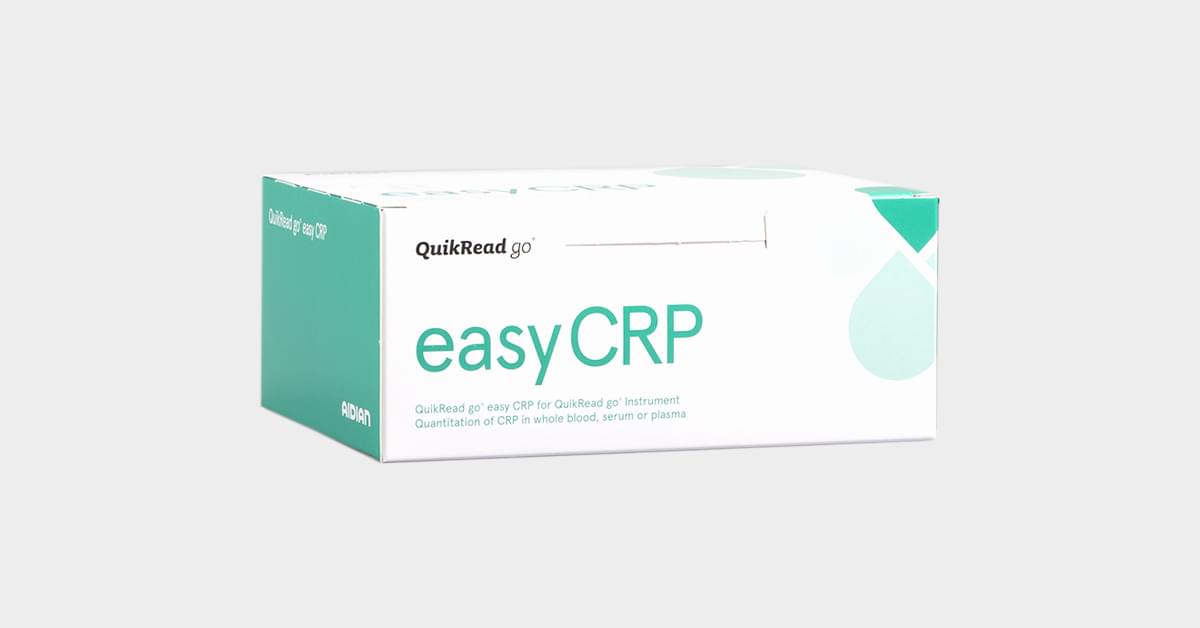Point of care CRP testing improves the patient care for family doctors
Rapid results, enhanced decision-making, and efficient patient management using QuikRead go®
Point of Care (POC) C-reactive protein (CRP) testing could transform the way family doctors diagnose and treat patients. CRP aids in the clinical management of patients with infections or inflammatory conditions. CRP production is proportional to the intensity of infection and inflammation. The short analysis time and a small sample volume of point of care CRP tests offer a substantial benefit compared to the laboratory CRP test. When used together with the clinical examination of a patient, QuikRead go CRP tests are excellent tools in the following situations:
- differentiation of mild and severe infections
- increasing diagnostic certainty and guiding appropriate antibiotic prescribing in acute infections1,2
- evaluation, monitoring, and prediction of the infection course, inflammation and treatment response3-5
- ruling out severe bacterial infection6

With the POC CRP testing approach, family doctors can now experience a multitude of benefits, that help in primary care:
- Rapid results: POC CRP testing provides family doctors with immediate access to patients’ CRP levels, allowing them to make timely and informed decisions. Within 2 minutes, doctors can obtain accurate CRP measurements using QuikRead go system, aiding in the diagnosis, and monitoring of various conditions, including infections and inflammatory diseases.1-6
- Enhanced decision-making: With immediate CRP results, family doctors can make more precise and evidence-based decisions regarding treatment plans. POC CRP testing enables doctors to determine the severity of infections, guide antibiotic prescribing practices, and identify patients who may require further investigations or secondary care referrals.7
- Targeted antibiotic prescribing: Overprescribing of antibiotics has become a global concern, contributing to antimicrobial resistance (AMR). POC CRP testing empowers family doctors to differentiate between mild and severe infections more effectively. By measuring CRP levels, physicians can identify patients who truly require antibiotics, reducing unnecessary prescriptions, and promoting responsible use of antibiotics.2,3
- Streamlined patient management: POC CRP testing facilitates efficient patient management within primary care settings. A quick and reliable on-site result reduces the patient’s waiting time and, at the same time, also the need for nursing resources for monitoring patients. Doctors can utilize CRP measurements to assess treatment response, monitor disease progression, and adjust medication dosages accordingly. This streamlined approach leads to improved patient outcomes and optimized resource utilization.8
- Cost-effectiveness: Integrating POC CRP testing into family practice can result in cost savings. By utilizing targeted antibiotic prescribing and minimizing unnecessary investigations, such as imaging or specialist consultations, primary care can allocate resources more efficiently while providing cost-effective care to patients.9
With rapid results, enhanced decision-making capabilities, and streamlined patient management, family doctors can deliver more accurate and personalized care to their patients. This approach promotes evidence-based medicine, reduces healthcare costs, and contributes to the overall well-being of not only individuals and communities, but also has a global impact on the AMR development.
To learn more about QuikRead go system, come and visit Aidian at WONCA Europe 2023 in Brussels during 8–10 June 2023!
References:
- Markanday A. Acute Phase Reactants in Infections: Evidence-Based Review and a Guide for Clinicians. Open Forum Infect Dis 2015; 2(3): ofv098.
- Little P et al. Effects of internet-based training on antibiotic prescribing rates for acute respiratory-tract infections: a multinational, cluster, randomised, factorial, controlled trial. Lancet 2013; 382(9899): 1175-1182.
- Tonkin-Crane SKG et al. Clinician-targeted interventions to influence antibiotic prescribing behaviour for acute respiratory infections in primary care: an overview of systematic reviews (Review). Cohcrane Database of Systematic Reviews 2017; 7(9): CD012252.
- Bruns AH et al. Usefulness of consecutive C-reactive protein measurements in follow-up of severe community-acquired pneumonia. Eur Respir J 2008; 32(3): 726-732.
- Verhagen DW et al. Prognostic value of serial C-reactive protein measurements in left-sided native valve endocarditis. Arch Intern Med 2008; 168(3): 302-307.
- Emery P. Evidence-based review of biologic markers as indicators of disease progression and remission in rheumatoid arthritis. Rheumatol Int 2007; 27(9): 793-806.
- Aabenhus, R., Hansen, M. P., Saust, L. T., Bjerrum, L., & Gahrn-Hansen, B. (2014). Clinical indications for antibiotic use in Danish general practice: results from a nationwide electronic prescription database. Scandinavian Journal of Primary Health Care, 32(4), 234-241. doi: 10.3109/02813432.2014.986970
- Aabenhus, R., Jensen, J. U., Jorgensen, K. J., Hróbjartsson, A., & Bjerrum, L. (2014). Biomarkers as point-of-care tests to guide prescription of antibiotics in patients with acute respiratory infections in primary care. Cochrane Database of Systematic Reviews, 11, CD010130. doi: 10.1002/14651858.CD010130.pub2
- Cals JW, Ament AJ, Hood K, et al. C-reactive protein point of care testing and physician communication skills training for lower respiratory tract infections in general practice: economic evaluation of a cluster randomized trial. J Eval Clin Pract. 2011;17(6):1059–1069.


